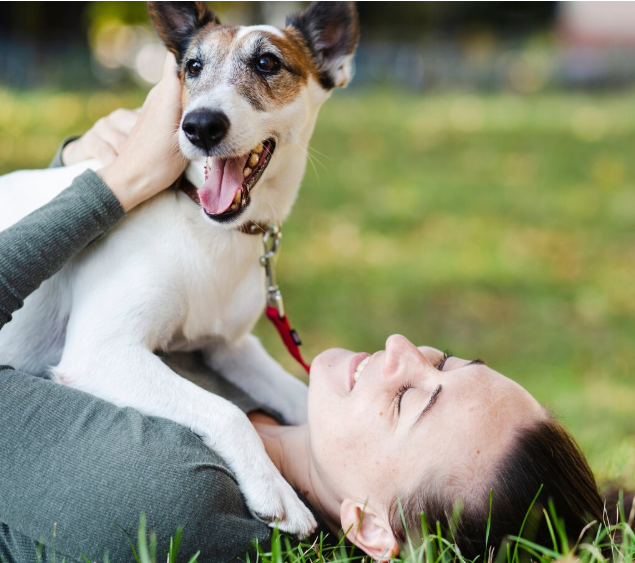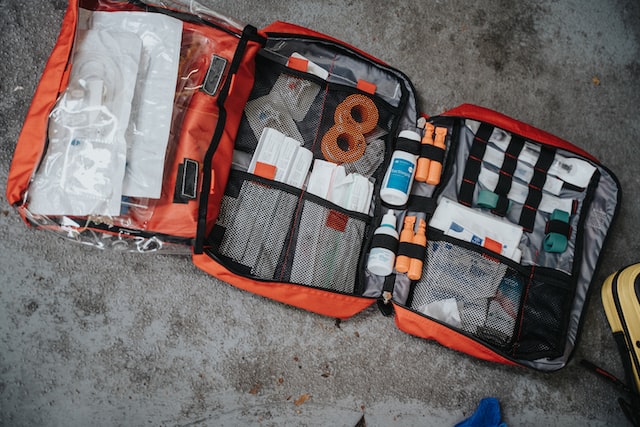
It’s an awful feeling to receive the following ‘advice’ from a close one: “Why can’t you just be happy?” It sounds easy to those who haven’t experienced trauma and don’t see daily life as an unpredictable battlefield! Emotional flashbacks, hypervigilance, overwhelming sense of fear or distrust, intrusive thoughts, nightmares...it’s a long list of symptoms accompanying Complex PTSD!
While therapy and medication offer essential support, they don’t always address the persistent, real-world challenges of navigating everyday life. This is where service dogs step in! They are not just companions but highly trained assistants who become a vital part of their owners’ lives!
Today’s article is dedicated to those living with ‘hidden’ disabilities like C-PTSD. We hope it helps raise awareness!
What Is Complex PTSD (C-PTSD)?
Complex Post-Traumatic Stress Disorder (C-PTSD) is a mental health condition that results from prolonged or repeated trauma, such as childhood abuse, domestic violence, or combat exposure. Traumatic experiences often involve situations where escape feels impossible for the affected person.

Common Causes of C-PTSD
While the causes are also related to traumatic experiences, these may vary from person to person. However, the most common ones are:
Childhood Trauma
- Chronic abuse (physical, emotional, sexual)
- Neglect or abandonment by caregivers
- Growing up in a highly dysfunctional or unsafe home
- Exposure to domestic violence
Long-Term Abuse or Exploitation
- Domestic violence (being in an abusive relationship)
- Human trafficking or forced labor
- Religious or cult abuse
Captivity or Oppression
- Prisoners of war (POWs) or hostages
- Long-term institutional abuse (e.g., in orphanages or psychiatric hospitals)
- Surviving war, genocide, or systemic oppression
Repeated Exposure to Trauma in High-Stress Environments
- First responders, medical professionals, and social workers who are constantly exposed to trauma
- Repeated combat exposure in military service

Symptoms of C-PTSD
Individuals with C-PTSD often struggle with controlling their emotions and may experience intense mood swings. These may lead to reactions that appear disproportionate to the situation.
Difficulty Managing Emotions
It can manifest as:
- Sudden outbursts of anger or frustration
- Uncontrollable sadness or crying episodes
- Feeling emotionally numb or disconnected
- Difficulty identifying and expressing emotions
- Engaging in self-harm or other destructive coping mechanisms
Chronic Anxiety and Hypervigilance
People with C-PTSD often remain in a state of heightened alertness, as their nervous system is constantly scanning for potential threats. This hypervigilance can make it difficult for them to relax, even in safe environments, as their brain continues to scan the environment for potential danger.
Strong reactions to sudden noises or movements, and difficulty with feeling at ease in unfamiliar or crowded spaces are also common symptoms. Over time, this constant state of alertness can lead to exhaustion, anxiety, and issues with functioning in daily life.
With that said, we would summarize the symptoms in this point as follows:
- Persistent feelings of fear or unease, even in safe settings
- Exaggerated response to sudden noises or movements
- Difficulty relaxing or feeling safe in social situations
- Panic attacks or overwhelming anxiety as a response to triggers
Flashbacks and Dissociation
C-PTSD can cause individuals to relive traumatic experiences in a distressing way. These can manifest as:
- Vivid flashbacks that make the person feel as if they are re-experiencing the trauma
- Nightmares or night terrors related to past events
- Dissociation (feeling detached from reality, body, or emotions)
- Memory lapses or "losing time" due to dissociative episodes
Negative Self-Perception and Guilt
The disorder often causes individuals to have strong negative beliefs about themselves, which may include:
- Feeling unworthy, damaged, or permanently broken
- Blaming themselves for the trauma, even if it was out of their control
- Persistent feelings of guilt or shame, even for things outside their responsibility
- Difficulty accepting kindness or positive feedback from others
Difficulty Building Relationships and Social Withdrawal
Since C-PTSD often develops from interpersonal trauma, trusting others and forming connections can be challenging. Common symptoms include:
- Avoiding relationships due to fear of betrayal or further harm
- Difficulty trusting people, even those with good intentions
- Feeling disconnected or emotionally distant in relationships
- Struggles with setting boundaries or feeling safe in social settings
- A pattern of unhealthy or codependent relationships
Physical Symptoms and Health Issues
The chronic stress of C-PTSD doesn’t just affect the mind, it can also have a strong negative impact on the body. We will list below the common physical signs of the disorder:
- Chronic fatigue and exhaustion
- Physical discomfort and pain without a clear medical reason
- Gastrointestinal issues (stomach pain, nausea, Irritable bowel syndrome (IBS))
- Frequent headaches or migraines
- Insomnia or disrupted sleep

What Are Service Dogs?
Service dogs are individually trained dogs who perform specific tasks directly related to a disability, whether physical or mental.
You may already know this, but it’s important to emphasize what defines a service dog and to clarify (again) the difference between service dogs and emotional support animals. Unlike emotional support animals, service dogs don’t just provide comfort and companionship, they are trained to perform specific tasks tailored to their handler’s needs.
How Can a Service Dog Help an Individual with C-PTSD?
As mentioned in the previous paragraphs, C-PTSD symptoms can vary and may be psychological, behavioral, or physical.
With that said, a service dog can be trained to perform specific tasks based on the individual’s needs.
Interrupting Repetitive and Potentially Harmful Behaviors
During anxiety episodes, panic attacks, or flashbacks, individuals may engage in repetitive behaviors, such as scratching their skin until it bleeds. Service dogs can be trained to recognize and interrupt these behaviors by performing specific tasks, i.e. nose-nudging, pawing or giving a kiss.
Once the dog associates a specific behavior with a positive outcome (such as a reward or praise), they will naturally try to get your attention when they notice it.
The type of task/intervention your dog performs as a preventative measure entirely depends on the person and what best works for them.
Grounding the Owner
For a service dog to ground their owner means, they help bring the person back to the present moment during episodes of anxiety, dissociation, panic attacks, or flashbacks. Grounding techniques are particularly useful for individuals with conditions like PTSD, C-PTSD, or severe anxiety disorders.
This task can be performed in various ways, including Deep Pressure Therapy (DPT), and other types of tactile stimulation, i.e. licking, nudging, or pawing to provide physical contact and redirect attention, as well as barking, or bringing a specific object.
Waking Up the Owner From Nightmares
Service dogs for individuals with C-PTSD can help wake their handlers from nightmares using trained responses. This task helps prevent distress, dissociation, or panic episodes upon waking.
Typically, the training process involves teaching the dog to recognize signs of nightmares, such as increased heart rate, sweating, or restless and abrupt movements. The handler can simulate nightmare behaviors during training, and reward their dog for showing the trained behaviors.
A service dog can be trained to wake their owner up by exhibiting various behaviors such as nudging or licking the handler’s face, arms, or legs; pawing or applying gentle pressure to wake them.
Deep Pressure Therapy (DPT)
Speaking of applying gentle pressure, it's important to mention Deep Pressure Therapy—an essential task that can benefit individuals with C-PTSD! A service dog can use their body weight to apply pressure by either lying on their owner’s lap or resting their chin on it. DPT is known for its strong calming effect.
Crowd Control
Many people with C-PTSD feel discomfort in crowded areas. A service dog can be trained to create a physical barrier between their handler and other people. This helps reduce individuals’ anxiety in public settings and ensures they feel safer in social environments.
Alerting to Emotional or Physical Distress
Naturally friendly and people-oriented dogs who share strong bonds with their owners can sense changes in their emotions, behavioral patterns, and physiological responses.
With proper training, handlers can further shape their dogs’ behaviors and train them to recognize and respond to signs of emotional or physical distress.
To ensure consistency, dogs should be exposed to various environments and scenarios where the handler experiences distress. This process is known as ‘generalizing the behavior.’
Pairing the dog’s alert behavior with rewards helps reinforce the response. Over time, the dog learns to recognize even subtle cues and respond accordingly.
Guiding the Owner to a Safe Space
In cases of emotional overwhelm or dissociation, which are common symptoms of C-PTSD, a service dog can guide their handler away from triggering environments.
They can lead them to a safe place, such as an exit, a quiet room, or even a specific individual.
Reminding the Owner to Take Medication
For individuals who take medication to manage symptoms of C-PTSD, a service dog can be trained to provide reminders at specific times of the day. This is particularly useful for those who may struggle with memory issues due to trauma.
Retrieving Medication
Additionally, service dogs can support their handler with retrieving medication. For those who experience dissociation, having a service dog trained to bring medication, can be a great way to stay on track and maintain their routine.

How to Get a Service Dog for C-PTSD?
Obtaining a Trained Service Dog
There are numerous organizations and trainers specializing in different areas of dog training, including puppy development, basic obedience, and service dog training for various tasks. Some organizations train dogs from a young age to become service animals, and the process of training and placing them with an individual typically takes about two years.
The cost of a fully trained service dog can reach up to $20,000 - $30,000, due to the extensive care, socialization, and training these dogs receive to ensure they can perform their tasks reliably.
An undeniable benefit of receiving a fully trained service dog is that the organization has already handled the most challenging aspects, including evaluating, potty training, and teaching obedience, specialized skills, and good manners in public.
However, this approach also has its disadvantages. Aside from the cost, the user (the individual who will benefit from the performed tasks) does not participate in the dog’s training and socialization. This means that they have to build a relationship from the very beginning.
Additionally, they will need to undergo training themselves to learn how to work effectively with their new service dog. The long waiting lists accompanying the process of getting a trained service dog through a non-profit organization are another important factor to consider. It may take up to several years to obtain a trained dog.
Training a Service Dog with a Professional Trainer or Organization
A more cost-effective alternative to purchasing or applying for a fully trained service dog is to work with a trainer, school, or organization to train your pet dog. While this option still involves significant expenses, it is generally more affordable than obtaining an already-trained dog.
The cost will vary depending on factors such as the type and duration of the program, the trainer’s experience, location, and whether training is conducted in a group or individual setting. In some cases, boarding and training programs can cost around $1,000 to $2,000 per week.
Training your pet dog with the help of a trainer, allows owners to be actively engaged in the training process, which can strengthen the bond between them and their dogs. Furthermore, working with an experienced trainer can provide guidance and support throughout the training journey.
However, there are also potential downsides, including the costs, the risk of receiving limited attention in group sessions, and the need to adhere to the trainer’s schedule rather than your own.
Owner-Training a Service Dog
Many individuals choose to train their own service dogs, either independently or through structured owner/self-training programs like ours. This approach has become popular among many dog owners in the past years due to its flexibility, lower cost, and the opportunity to build a strong connection with the dog.
There are many online resources available to assist dog owners, including videos, courses, and training guides. However, self-training requires a structured approach, a high level of dedication, patience, and consistency to be effective.
For those of you seeking easy-to-follow, self-paced, and well-structured programs with tutor support, our courses may be the right fit! However, it’s important to note that while owner/self-training a service dog offers financial and scheduling advantages, it also requires time, effort, and commitment.
Choosing the Right Training Approach
Before selecting a training program, school, organization, or private trainer, thorough research is essential.
We strongly recommend considering key factors such as cost, training methods (we advise you to opt for programs based on positive reinforcement and humane techniques), the level of owner involvement, and the program’s duration. It’s also crucial to ensure that the program/trainer/organization aligns with your values and needs.












